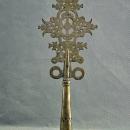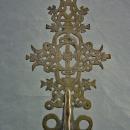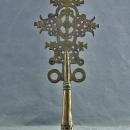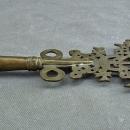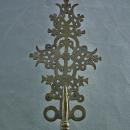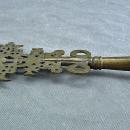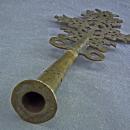17th -18th century Ethiopia Solomonic Dynasty







$600.00
Or Best OfferAn exceptional example of the antique Ethiopian Coptic Christian processional cross of unusual form 17th -18th century Ethiopia, Solomonic Dynasty.
The cross is made of cast copper alloy (white bronze) and has been pierced and engraved in openwork with an intricate pattern of interwoven lines, topped with small crosses. Two circular decorations flank the bottom of the cross; this motif refers to the divine halo of Christ. The cross is mounted on a tapering conical socket decorated with a pierced zigzag pattern.
The cross consists of two separately cast pieces: the cross and the socket. The cross was then slid into the socket and welded together.
The snake-like finials are a reference to the brazen serpent of Moses, as described in the Book of Numbers (21:4-9). After a plague of poisonous snakes devastated the Israelites, God instructed them to erect a brass serpent on a pole. It was believed that gazing upon this object would cure those who had been bitten. Christians interpreted the brazen serpent as a foreshadowing of the redemptive cross of Christ.
As an object sanctified by the blood of Christ, the cross is an essential element of religious practice in Ethiopia, serving as a powerful symbol of triumph and protection since at least the 4th century AD.
Ethiopia was the second country after Armenia to adopt Christianity. There is evidence that Christianity flourished in Ethiopia as early as the first century AD, and for most of the country's history, Orthodox Christianity was the state religion. Individual patrons ordered crosses like this one from artisans to be distributed to religious institutions as acts of devotion.
Processional crosses are an integral part of religious ceremonies carried by priests during processions that are held on special occasions, such as the Epiphany. These crosses, which are mounted on long staffs, are highly symbolic, representing the crucified figure of Christ. When in use, they are adorned with rich, colorful fabrics that add to their beauty and significance.
The brass processional cross was traditionally made through the lost-wax casting process, in which the cross is first crafted in wax, then covered in clay, and fired. During the firing process, the wax melts and flows out of the clay mold. The crevice is then filled with molten brass, and after the metal hardens, the clay mold is broken to reveal a brass cross. Because the mold is destroyed, the lost-wax casting process produces a unique cross each time.
Due to the high demand for antique Ethiopian Ecclesiastical Art, the market has been flooded with reproductions of Ethiopian processional crosses that have recently been made in Ethiopia, Egypt, and Morocco. However, we would like to assure our clients that the Blessing Cross we are offering is a 100% authentic antique 19th-century Ethiopian Solomonic dynasty Coptic processional cross.
The buyer will be provided with a certificate of authenticity.
CONDITION: Overall, in good condition with an old patina, shows age and use. The cross is slightly warped, with some dents to the socket (consistent with age).
DIMENSIONS:
High: 36.5 cm (14.37 inches).
Width: 13.5 cm (5.31 inches).
PROVENANCE: French Art Market.
Please see the links below for related Ethiopian processional crosses in the Museum's Collections:
https://www.metmuseum.org/art/collection/search/320341
https://www.metmuseum.org/art/collection/search/652539
https://www.metmuseum.org/art/collection/search/677838
https://art.thewalters.org/detail/4545/processional-cross/
https://art.thewalters.org/detail/34875/processional-cross-8/
https://art.thewalters.org/detail/16014/processional-cross-4/
